fuel OLDSMOBILE SILHOUETTE 1998 Owners Manual
[x] Cancel search | Manufacturer: OLDSMOBILE, Model Year: 1998, Model line: SILHOUETTE, Model: OLDSMOBILE SILHOUETTE 1998Pages: 444, PDF Size: 23.2 MB
Page 11 of 444
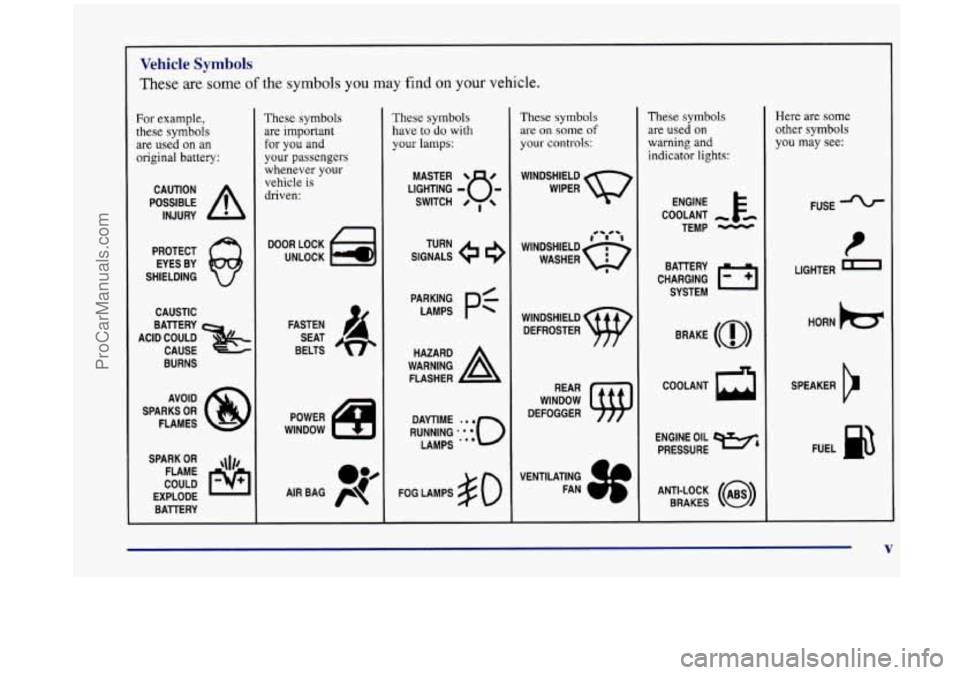
Vehicle Symbols
These are some of the symbols you may find on your vehicle.
For example,
these symbols are used on an
original battery:
POSSIBLE A
CAUTION
INJURY
PROTECT EYES BY
SHIELDING
CAUSTIC
ACID COULD BAllERY
CAUSE
BURNS
AVOID
SPARKS
OR
FLAMES
SPARK
OR ,\I/,
COULD FLAME
EXPLODE BAllERY
These symbols
are important
for you and
your passengers
whenever
your
vehicle is
driven:
DOOR LOCK
UNLOCK
FASTEN SEAT
BELTS
These symbols
have to do with
your lamps:
SIGNALS e
TURN
WARNING
A
HAZARD
FLASHER
FOG LAMPS
$0
These symbols
are on some of
your controls:
WINDSHIELD
WIPER
WINDSHIELD DEFROSTER
WINDOW
DEFOGGER
These symbols
are used on
warning and indicator lights:
ENGINE E*
COOLANT
TEMP
-
CHARGING I-1
BATTERY
SYSTEM
BRAKE
(a)
COOLANT a
ENGINE OIL e,
PRESSURE
ANTI-LOCK
(@)
BRAKES
Here are some other symbols you may see:
FUSE
LIGHTER
m
HORN )cr
SPEAKER
b
FUEL e3
ProCarManuals.com
Page 116 of 444
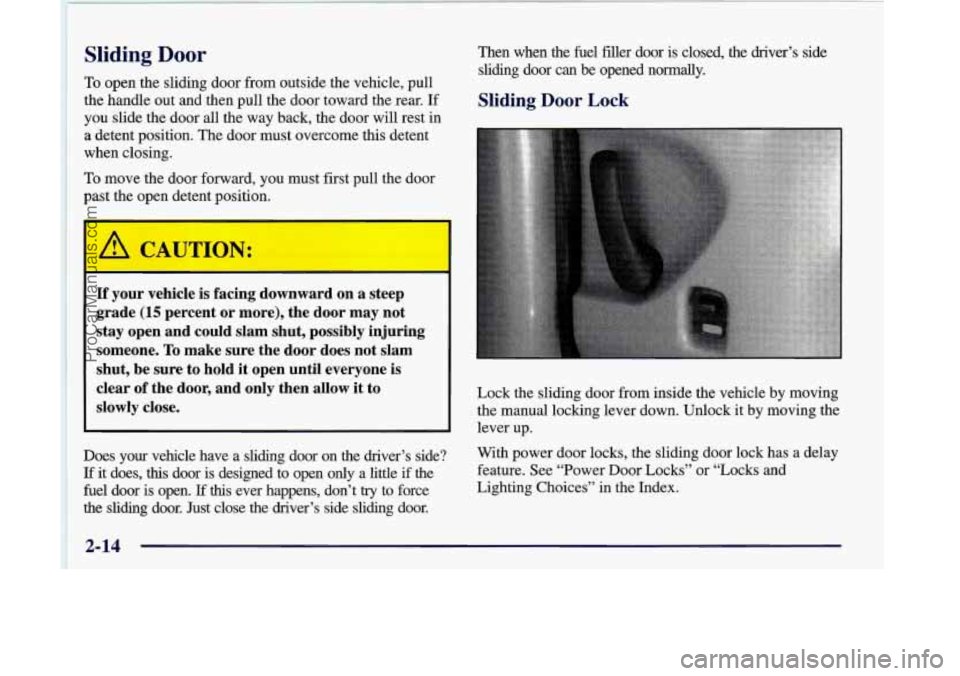
Sliding Door
To open the sliding door from outside the vehicle, pull
the handle out and then pull the door toward the rear. If
you slide the door all the way back, the door will rest in
a detent position.
The door must overcome this detent
when closing.
To move the door forward, you must first pull the door
past the open detent position.
If your vehicle is facing downward on a steep
grade
(15 percent or more), the door may not
stay open and could slam shut, possibly injuring
someone.
To make sure the door does not slam
shut, be sure to hold it open until everyone is
clear of the door, and only then allow
it to
slowly close.
Does your vehicle have a sliding door on the driver’s side?
If it does, this door is designed to open only a little if the
fuel door is open.
If this ever happens, don’t try to force
the sliding door. Just close the driver’s side sliding door.\
Then when the
fuel filler door is closed, the driver’s side
sliding door can be opened normally.
Sliding Door Lock
Lock the sliding door from inside the vehicle by moving
the manual locking lever down. Unlock it by moving the
lever up.
With power door locks, the sliding door lock has a delay
feature. See “Power Door Locks” or “Locks and
Lighting Choices” in the Index.
2-14
ProCarManuals.com
Page 125 of 444
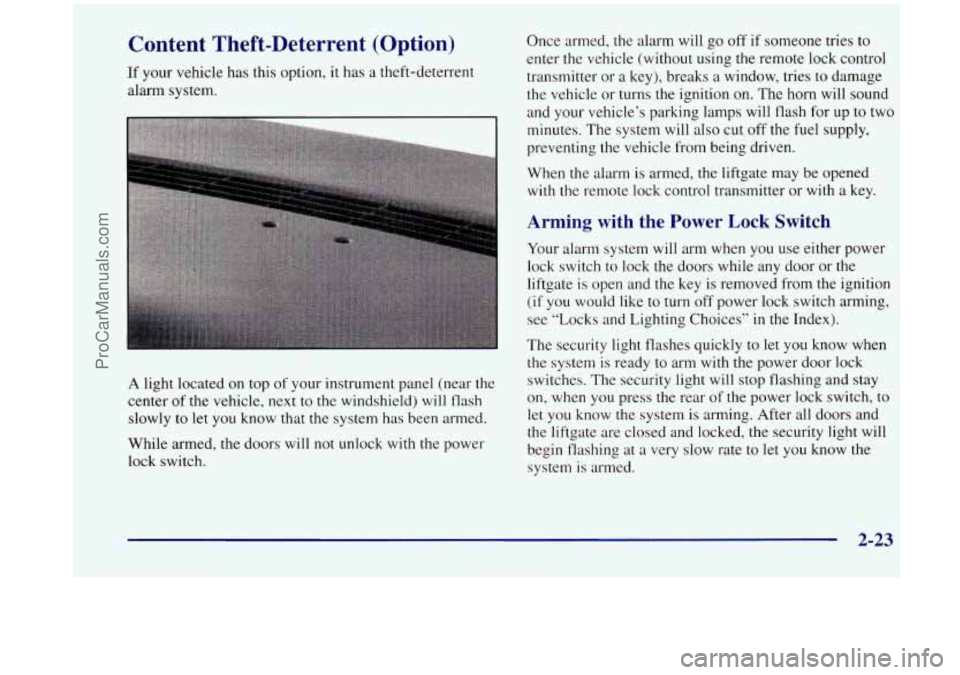
Content Theft-Deterrent (Option)
11 your vehicle has this option, it has a theft-deterrent
alarm system.
A light located on top of your instrument panel (near the
center of the vehicle,
next to the windshield) will flash
slowly to let you know that the system has been armed.
While armed, the doors will not unlock with the power
lock switch. Once armed,
the alarm will go off if
someone tries to
enter the vehicle (without using the remote lock control
transmitter or
a key), breaks a window, tries to damage
the vehicle or turns the ignition on. The horn will sound
and your vehicle’s parking lamps will flash for up to two
minutes. The system will also cut off the fuel supply,
preventing the vehicle from being driven.
When the alarm is armed, the liftgate may be opened
with the remote lock control transmitter or with a key.
Arming with the Power Lock Switch
Your alarm system will arm when you use either power
lock switch to lock the doors while any door or the
liftgate is open and the key is removed from the ignition
(if you would like to turn off power lock switch arming,
see “Locks and Lighting Choices”
in the Index).
The security light flashes quickly to let you know when
the system is ready
to arm with the power door lock
switches. The security light will stop flashing and stay
on, when
you press the rear of the power lock switch, to
let you know the system is arming. After all doors and
the liftgate are closed and locked, the security light will
begin flashing at
a very slow rate to let you know the
system is armed.
2-23
ProCarManuals.com
Page 131 of 444
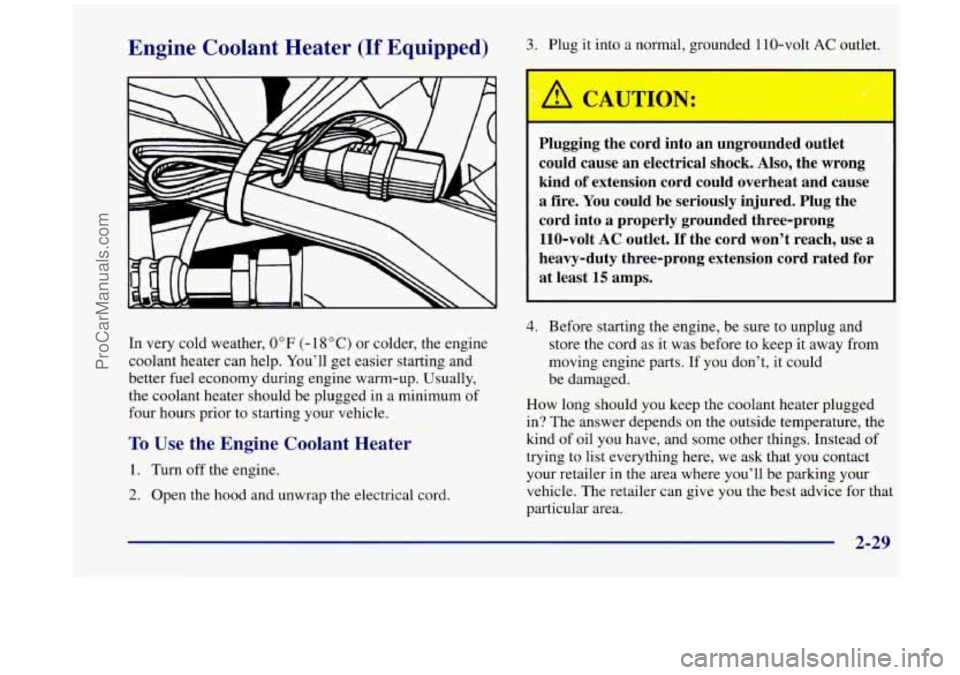
Engine Coolant Heater (If Equipped) 3. Plug it into a normal, grounded 110-volt AC outlet.
Plugging the cord into
an ungrounded outlet
could cause an electrical shock. Also, the wrong
kind
of extension cord could overheat and cause
a fire. You could be seriously injured. Plug the
cord into
a properly grounded three-prong
110-volt
AC outlet. If the cord won’t reach, use a
heavy-duty three-prong extension cord rated for
at least
15 amps.
In very cold weather,
0°F (- 18 “C) or colder, the engine
coolant heater can help. You’ll get easier starting and
better fuel economy during engine warm-up. Usually,
the coolant heater should be plugged in a minimum of
four hours prior to starting your vehicle.
To Use the Engine Coolant Heater
1. Turn off the engine.
2. Open the hood and unwrap the electrical cord.
4. Before starting the engine, be sure to unplug and
store the cord as it was before to keep it away from
moving engine parts.
If you don’t, it could
be damaged.
How long should
you keep the coolant heater plugged
in? The answer depends on the outside temperature, the
kind
of oil you have, and some other things. Instead of
trying to list everything here, we ask that you contact
your retailer in the area where you’ll be parking your
vehicle. The retailer can give
you the best advice for that
particular area.
2-29
ProCarManuals.com
Page 134 of 444

AUTOMATIC OVERDRIVE (D): This position is
for normal driving. If you need more power for passing,
and you’re:
Going less than 35 mph (55 km/h), push your
accelerator pedal about halfway down.
0 Going about 35 mph (55 km/h) or more, push the
accelerator all the way down.
You’ll shift down to the next gear and have more power.
THIRD (3): This position is also used for normal
driving, but it offers more power and lower fuel
economy than AUTOMATIC OVERDRIVE (D).
Here are some times you might choose THIRD
(3)
instead of AUTOMATIC OVERDRIVE (D):
0 When driving on hilly, winding roads.
0 When towing a trailer (so there is less shifting
0 When going down a steep hill.
between gears).
SECOND (2): This
position gives you more power, but
lower fuel economy. You can use
SECOND (2) on hills.
It can help control your speed as
you go down steep
mountain roads, but then you would also want to
use
your brakes off and on.
I NOTICE:
Don’t drive in SECOND (2) for more than 25 miles
(40 km), or at speeds over 55 mph (90 km/h), or
you can damage your transaxle. Use THIRD
(3) or
AUTOMATIC
OVERDRIVE (D) as much as
possible. Don’t shift into SECOND (2) unless you
are going slower than 65 mph (105 km/h) or you
can damage your engine.
2-32
ProCarManuals.com
Page 135 of 444

NOTICE:
If’ your vehicle seems to start up rather slowly, or
if it seems not to shift gears as you go faster,
something may be wrong with a transaxle system
sensor.
If you drive very far that way, your
vehicle can be damaged.
So, if this happens, have
your vehicle serviced right away. Until then, you
can use
SECOND (2) when you are driving less
than
35 mph (55 km/h) and THIRD (3) for
higher speeds. FIRST
(1): This position
gives you even more power
(but lower fuel economy) than SECOND (2). You can
use it on very steep hills, or in deep snow or mud. If the
selector lever is put in
FIRST (1), the transaxle won’t
downshift into first gear until the vehicle is going
slow enough.
NOTICE:
If your front wheels can’t rotate, don’t try to
drive. This might happen
if you were stuck in
very deep sand or mud or were up against a solid
object. You could damage your transaxle.
Also, if you stop when going uphill, don’t hold
your vehicle there with
only the accelerator
pedal. This could overheat and damage the
transaxle. Use your brakes or shift into PARK
(P)
to hold your vehicle in position on a hill.
2-33
ProCarManuals.com
Page 185 of 444
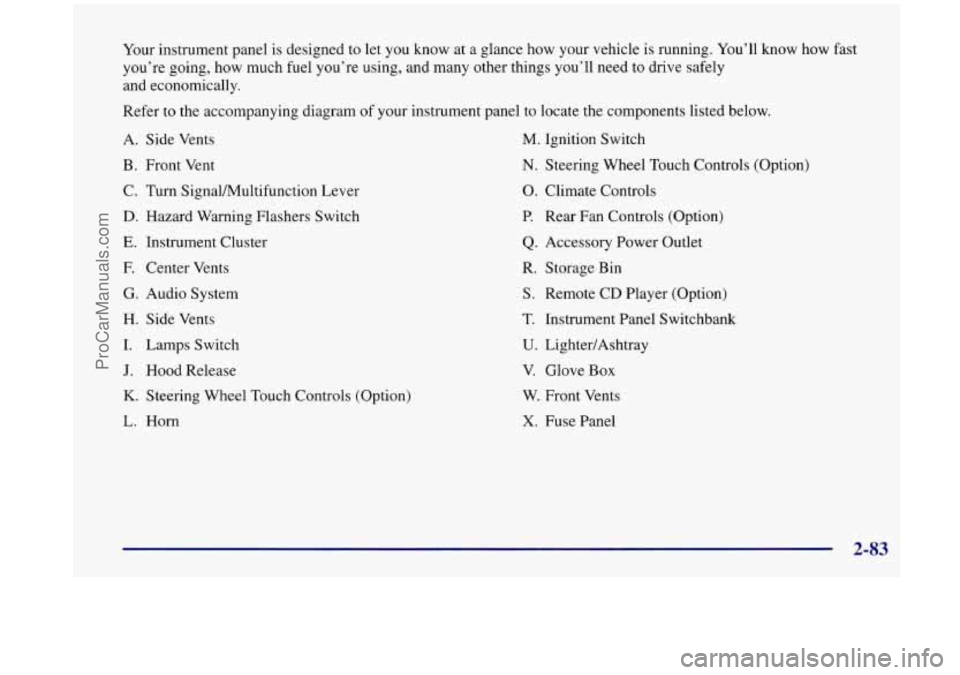
Your instrument panel is designed to let you know at a glance how your vehicle is running. You’ll know how fast
you’re going, how much fuel you’re using, and many other things you’ll need to drive safely
and economically.
Refer to the accompanying diagram of your instrument panel to locate the components listed below.
A. Side Vents
B. Front Vent
C. Turn SignalMultifunction Lever
D. Hazard Warning Flashers Switch
E. Instrument Cluster
F. Center Vents
G. Audio System
H. Side Vents
I. Lamps Switch
J. Hood Release
K. Steering Wheel Touch Controls (Option)
L. Horn
M. Ignition Switch
N. Steering Wheel Touch Controls (Option)
0. Climate Controls
P. Rear Fan Controls (Option)
Q. Accessory Power Outlet
R. Storage Bin
S. Remote CD Player (Option)
T. Instrument Panel Switchbank
U. LightedAshtray
V. Glove Box
W. Front Vents
X, Fuse Panel
2-83
ProCarManuals.com
Page 195 of 444
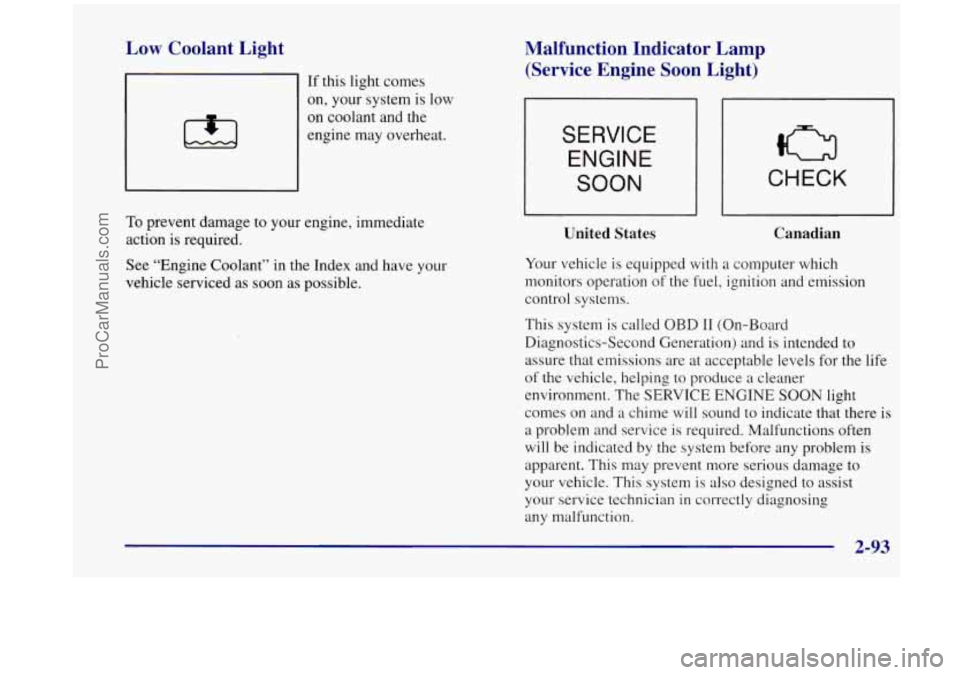
Low Coolant Light
If this light comes
on, your system is low
on coolant and the
engine may overheat.
To prevent damage to your engine, immediate
action
is required.
See “Engine Coolant” in the Index and have your
vehicle serviced
as soon as possible.
Malfunction Indicator Lamp (Service Engine Soon Light)
SERVICE
ENGINE
SOON
United States
CHECK
Canadian
Your vehicle is equipped with a computer which
monitors operation
of the fuel, ignition and emission
control systems.
This system
is called OBD I1 (On-Board
Diagnostics-Second Generation) and is intended to
assure that emissions are at acceptable levels for the life
of the vehicle, helping to produce a cleaner
environment. The SERVICE ENGINE SOON light
comes on and
a chime will sound to indicate that there is
a problem and service is required. Malfunctions often
will be indicated by the system before any problem is
apparent. This may prevent more serious damage to
your vehicle. This system is
also designed to assist
your service technician
in correctly diagnosing
any malfunction.
2-93
ProCarManuals.com
Page 196 of 444

NOTICE:
If you keep driving your vehicle with this light
on, after a while, your emission controls may not
work as well, your fuel economy may not be as
good and your engine may not run as smoothly.
This could lead
to costly repairs that may not be
covered by your warranty.
This light should come on, as a check to show you it is
working, when the ignition is on and the engine is not
running. If the light doesn’t come
on, have it repaired.
This light will also come
on during a malfunction in one
of two ways:
Light Flashing -- A misfire condition has been
detected. A misfire increases vehicle emissions and
may damage the emission control system on your
vehicle. Retailer or qualified service center diagnosis
and service may be required.
Light On Steady -- An emission control system
malfunction has been detected
on your vehicle.
Retailer or qualified service center diagnosis and
service may be required.
If the Light Is Flashing
The following may prevent more serious damage to
your vehicle:
Reducing vehicle speed.
Avoiding hard accelerations.
Avoiding steep uphill grades.
If you are towing a trailer, reduce the amount of
cargo being hauled as soon as it
is possible.
If the light stops flashing and remains on steady, see “If
the Light Is On Steady” following.
If the light continues
to flash, when it is safe to do so,
stop the vehicle. Find a safe place to park your vehicle.
Turn the key off, wait at least 10 seconds and restart the
engine. If the light remains on steady, see “If the Light
Is On Steady” following. If the light is still flashing,
follow the previous steps, and drive the vehicle to your
retailer or qualified service center for service.
2-94
ProCarManuals.com
Page 197 of 444

If the Light Is On Steady
You may be able to correct the emission system
malfunction by considering the following:
Did you recently put fuel into your vehicle?
If
so, reinstall the fuel cap, making sure to fully install
the cap. The diagnostic system can determine if
the fuel
cap has been left off or improperly installed. A loose or
missing fuel cap will allow fuel to evaporate into the
atmosphere. A few driving trips with the cap properly
installed should turn the light off.
Did you just drive through a deep puddle of water?
If
so, your electrical system may be wet. The condition
will usually be corrected when the electrical system
dries out. A few driving trips should turn
the light off.
Are you low on fuel?
As your engine starts to run out of fuel, your engine may
not run as efficiently as designed since small amounts of
air are sucked into the fuel line causing a misfire. The
system can detect this. Adding fuel should correct this
condition. Make sure to install the fuel cap properly. It
will take a few driving trips to turn the light off. Have
you recently changed brands
of fwl?
If
so, be sure to fuel your vehicle with quality fuel (see
“Fuel” in the Index). Poor fuel quality will cause your
engine not to run as efficiently as designed. You may
notice this as stalling after start-up, stalling when you
put the vehicle into gear, misfiring, hesitation on
acceleration or stumbling on acceleration. (These
conditions may
go away once the engine is warmed up.)
This will be detected by the system and cause the light
to turn on.
If you experience one or more of these conditions,
change the fuel brand you use.
It will require at least one
full tank of the proper fuel to turn the light off.
If none of the above steps have made the light turn off,
have your retailer or qualified service center check the
vehicle. Your retailer has the proper test equipment and
diagnostic tools to fix any mechanical or electrical
problems that may have developed.
2-95
ProCarManuals.com